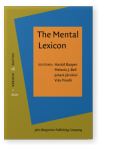Vol. 16:1 (2021) ► pp.23–48
Relative entropy effects on the processing of spoken Romanian verbs
A multitude of studies show the relevance of both inflectional paradigms (word form frequency distributions, i.e., inflectional entropy) and inflectional classes (whole class frequency distributions) for visual lexical processing. Their interplay has also been proven significant, measured as the difference between paradigm and class frequency distributions (relative entropy). Relative entropy effects have now been recorded in nouns, verbs, adjectives, and prepositional phrases. However, all of these studies used visual stimuli – either written words or picture-naming tasks. The goal of our study is to test whether the effects of relative entropy can also be captured in the auditory modality. Forty young native speakers of Romanian (60% female) living in Serbia as part of the Romanian ethnic minority participated in an auditory lexical decision task. Stimuli were 168 Romanian verbs from two inflectional classes. Verbs were presented in four forms: present and imperfect 1st person singular, present 3rd person plural, and imperfect 2nd person plural. The results show that relative entropy influences both response accuracy and response latency. We discuss alternative operationalizations of relative entropy and how they can help us test hypotheses about the structure of the mental lexicon.
Article outline
- Inflectional and relative entropy
- The current study
- Method
- Participants
- Stimuli
- Procedure
- Data analysis
- Results
- Response accuracy
- Response latency
- Discussion
- Conclusion
- Acknowledgements
- Author note
-
References
